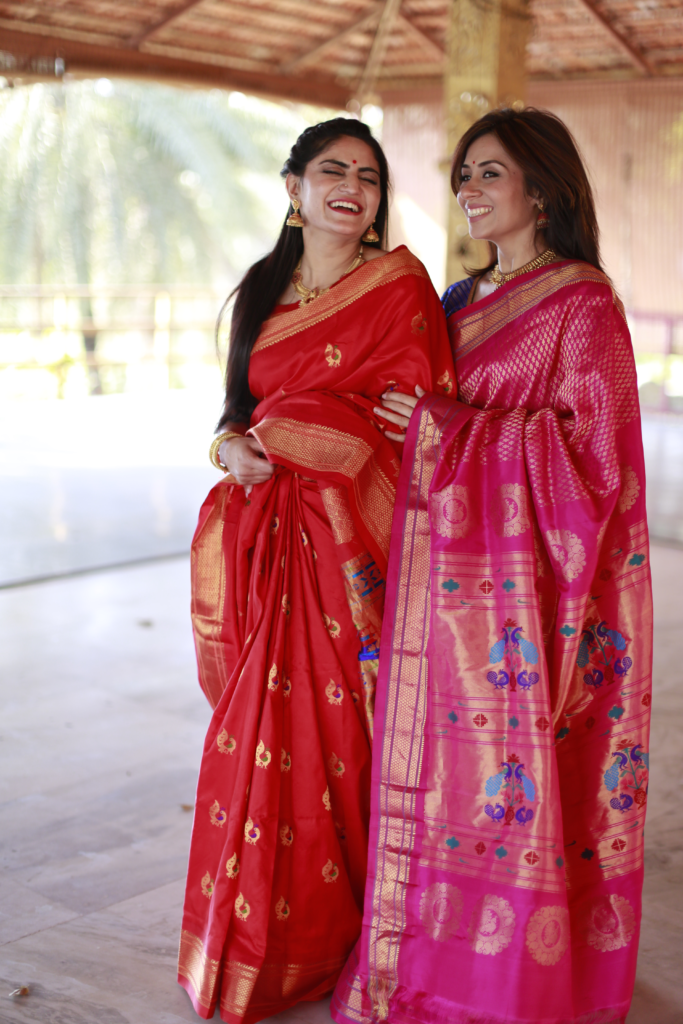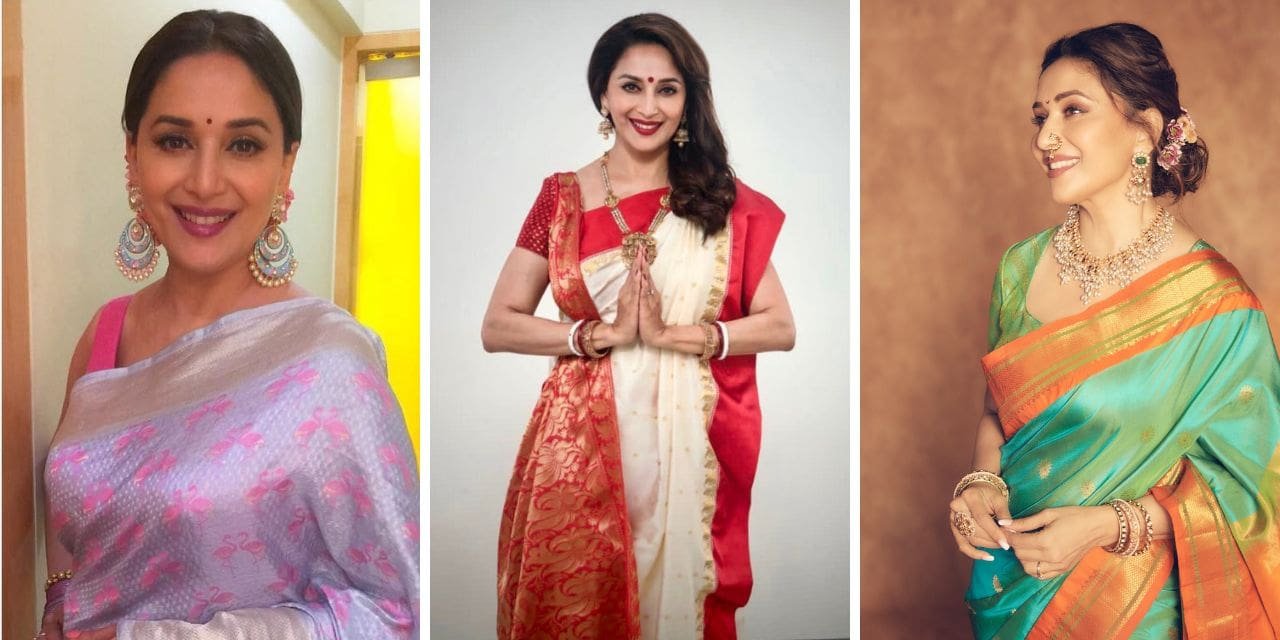Paithani is not just about peacocks and parrots, its history is as interesting as its tapestry weave
By Ranjani Govind

In our quest to bring you the minutiae of Indian weaving culture – in this new series on a handloom – we bring you closer to a handloom silk craft tradition, Paithani, dating back to 200 BC. Paithani, worn still in Maharashtrian social and religious functions with local pride, remains an heirloom. Being a must-include in every girl’s wedding trousseau, saris are known to last generations as they are made rich and strong.
With its origins in antiquity, the Paithani sari is said to have hailed from the royal dynasties of the medieval town of Paithan near Aurangabad. Named after the town, the sari is believed to have been originally made with the finest silk threads from China and pure zari that was spun locally.
IMAGE CREDIT: ‘MADHURYA’
Historically Paithan has always been centred around the weaving industry. Every household in Paithan was linked with weaving and ancillary activities such as dyeing the silk, winding the zari or even selling silks.

Signifying a history with the craft of Indian handloom, every piece typifies a luxurious spread of motifs with liberal use of gold, as well as floral and bird-inspired motifs. “It’s an interesting history. Our 2nd Century BC trade exchange show records of of Paithani silk being bartered for Roman wine and olive oil! Artisans of ancient Supratishthapuram city (presently known as Paithan) were gifted with this skill. Historians have noted that fine Paithani saris with delicate gold and silver thread-work were sold in Greece in exchange for gold too between 200 and 400 BC,” says weaver Ram Manohar who lives at Aurangabad in Maharashtra.
IMAGE CREDIT: ‘MADHURYA’
Ram Manohar hails from a family of silk weavers who preserve old records of ‘weaved Paithani material albums’ that serve as models for weavers and handloom aficionados. “These can serve as a reference for anyone taking up research work on handloom,” says Manohar. “My great-grandfather chose this city as it has always been a major production centre of cotton and artistic silk fabrics.”

The elaborate flowery designs and the ornate bird-inspired treatments are signature to any Paithani designery. They are part of the Paithani family of weaving that are now crafted from home grown silk threads and zari. “To create an accurate Paithani it takes 500 grams of silk threads and 250 gms of zari,” says Manohar, as the fourth-generation weaver has brought in creative touches with a modern twist to the classic Bangadi-Mor (bangle-peacock) motif of Paithani. “The painstaking process has taken three years for a single sari. It brings about bangle patterns running all over,” he says.
IMAGE CREDIT: ‘MADHURYA’

The contemporary varieties of the sari from Paithan and Yeol in Maharashtra are fashioned from homegrown silk threads from Bangalore, while the zari is sourced from Surat, according to 47-year-old Aseefa Khan from Yeol, who has been perfecting her Paithani skills on the loom for the last 30 years.
Gorgeous motifs in three types of weaving
The saris are named after the gorgeous motifs on them – tota-maina (parrot and maina); asawalli (flower and vine); narli (coconut); pejli (leaf) panja (flying peacock) zardari and Muniya (parrot in zari) on pure silk cloth base.
IMAGE CREDIT: ‘MADHURYA’
Weaving a Paithani sari can take anything between six months to two years, depending on the intricacy of the motif and design with three major types of weaving – the split tapestry weave, interlocking method, and dove-tailing method.
“We do not go around looking for raw material, as traders bring them all to us, and we only stick to our weaving, as we grew up meticulously observing and gradually learning the craft,” says Aseefa, adding that even an ordinary Paithani silk with minimum work in six yards costing Rs.25,000 will weigh 750 grams. “You can imagine the kind of gold work that goes into it! The nine-yard versions use more raw material and can weigh up to a kilogram,” adds Aseefa.
Yeola, hardly known to people with regard to its near-3000 Paithani weaver looms, is a quiet township in the Nashik District of Maharashtra. According to weaver Shirish Patil, the town was founded in the late 17th century by Raghujibaba Patil who moved here with families of master weavers. Amongst the generous spread of Havelis there, Shrinivas Soni, a 6th generation weaver with ancestral roots in Rajasthan from the shop Soni Paithani says his Haveli-shop is one of the oldest and well-known. “We have supplied Paithani saris to many film and television heroines. But with the film ‘Devdas’ we became more well-known as we supplied Paithani saris to Madhuri Dixit and Aishwarya Rai,” says Soni, his shop being amongst the near-100 Paithani dealers with weavers in Yeola.
Soni’s forefathers who settled in Yeola, “as they observed the demand for Paithani saris in 1857” wanted to take forward their ancestral legacy. Nearly 25,000 weavers live in Yeola and its neighbouring town Nagde now. Everyone works on traditional pit-loom or the newly introduced frame loom. “Richly besieged with motifs, the silk-and-gold Paithani saris were patronized by the Peshwas, and today Yeola has more number of looms than in Paithan village!” adds Soni.
Strong influences and re-creations
Today it’s common to see zari replaced with gold-like threads too in Paithani work. Says Bharathy Harish of the revival boutique Madhurya Creations, who customizes Paithani from Maharashtra, “The history of Paithani talks of a strong influence from both the Peshwa and the Moghul traditions. A Paithani is known for its trademark borders that classify them into its type – the Morbangadi (mor-peacock and bangdi – bangle); Munia – the parrot; and Brocade with florals and birds. The artistry is so accurate that one feels the flowers can be plucked from their branches in this weaving!”
Bharathy has had customers asking for different versions in a Paithani too. “We have got Manasarovar, mountains and lakes done and this kind of tapestry weave allows you to weave like a painting!” she says.
Although popular beliefs say Paithani was always made from pure silk, it dates back to a time when saris were available in pure cotton as well. Textile records in various museums speak of Paithani dating back to 200 BC used a fine cotton weave. “When the royals yearned for a dash of rich profusion in its weave, the weavers came up with introducing kora or shahtoot silks in its weave, and thus began its journey of being one of the icons in silks,” explains P. Saraf of Vyusti Saris.
The 2,000-year-old weave is done with the same technique as the Persian rug, says Arati Baandal of OnlyPaithani, a designer label that works to promote Paithani. Arati who had an exhibition held at Rain Tree in 2018 said she was also experimenting with colours. “Traditionally, a Paithani is done in purple, yellow, red, pink and bottle green. We are doing it in blue, mauve, grey and pastels. We are also creating them in checks and fusion borders.”
Distinguishing features
A Paithani weave is like gara embroidery with no threads hanging and doesn’t get entangled with accessories. With both sides of a Paithani looking exactly the same, a true Paithani is thus distinguished from the plethora of Paithani saris made on a power loom and other fakes in the market. Designers say one has to look for popular colours as reds, yellows, sky blues, magentas, greens, peach-pinks and purples with traditional motifs as parrots, peacocks, lotus, Ashraffi or the Asawalli and the pankha (fan) or muniya (parrot with red beak) borders.
The price of a Paithani sari varies from Rs. 6000 to Rs. 7 lakhs, depending on the artistry and the quantity of gold, zari and silver threads used in it.

